Recipes for Making Cured Beef Ham
How to salt cure ham at home has been on my homesteading bucket list for a few years now. Being able to preserve food with old-fashioned techniques, like salt curing pork, is a skill I find as fascinating as I do yummy. Bring me the bacon! And ham!
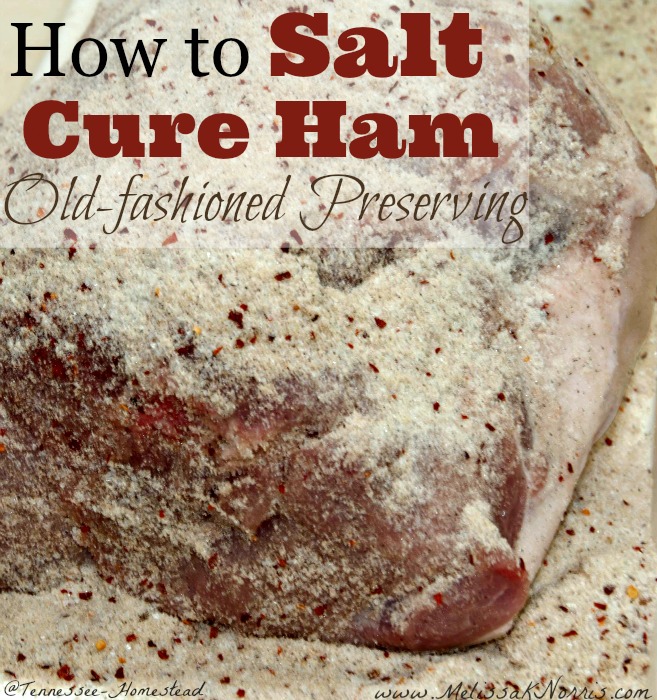
When Lee from Tennessee Homestead offered to teach me and you how to salt cure a ham I got all kinds of excited. Lee, teach away!
What is Salt Curing?
Salt curing ham is an age-old tradition on our homestead. We use a dry rub cure to make the best-tasting hams possible. The salt/sugar mix adds color and flavor to the meat. Additionally, some of our hams will also go into the smoker. But, today I will discuss with you the first part of the process, how to cure pork with a salt dry rub.
Before reliable refrigeration, people would salt cure meat the old fashioned way because it was the best way to preserve pork. Curing and smoking pulls the moisture from the ham to make it safe to store at room temperature. We don't cure for this purpose anymore, but rather to give the ham a great flavor and color.
Where can I buy a fresh ham to cure?
If you don't have a fresh ham from your own hog you can find fresh ham at a meat market or packing house. Remember the ham you buy at the grocery has already been cured and/or smoked. A fresh ham is exactly that, a ham fresh from the hog.
You can also ask around in rural areas to see if you can find someone raising their own hogs. Many times families will raise extra hogs to sell in order to offset the cost of raising them.
Is Salt Curing the Same as Dry Curing a Ham?
Yes, salt curing is simply another term for dry curing. This is a process of coating the meat with a salt cure rub which draws out the moisture. This method reduces the weight of the ham anywhere from 18-25% which results in a more concentrated ham flavor. Many people prefer dry curing as opposed to injecting or immersing the ham with a curing solution. Once the ham is cured, it can be smoked, cooked or frozen for later cooking. Because dry hams are typically saltier than other products, they benefit from soaking in water for 1-12 hours (in the refrigerator) before cooking.
Supplies Needed for Dry Curing a Ham
- Fresh Ham
- Curing mix – you must use a curing salt to make this mix, not regular salt. (Salt used to cure meat has to be non-iodized. If you use iodized salt it will make the meat have a metallic flavor.)
- Plastic tray – to use during the curing process. (Do not use metal)
- Sharp knife to cut in around joints
- Refrigerator (preferably an old refrigerator that can be sacrificed to the salt curing process. The salt will ruin the metal parts inside of the unit including the gills that disperse the cool air.)
- The Joy of Smoking and Salt Curing The Complete Guide to Smoking and Curing Meat, Fish, Game, and More (optional)
Homemade Salt Curing Mix
This dry rub mix recipe has been in my family and handed down for generations. It's a simple combination of four ingredients.
Does anyone else get giddy over these kinds of things? I may be a family recipe addict, it doesn't matter from whose family either. I know those recipes that get handed down are because they're just that good. ~Melissa
- 2 cups Curing Salt
- 1 Tbs Red pepper
- 1 Tbs Black pepper
- 1 cup Brown sugar
Most fresh hams will need a minimum of a triple batch, the recipe can be scaled up or down as needed, depending on size of the ham.
How to Salt Cure Ham at Home
- For one ham start with 6-8 cups of mix.
- The temperature will need to be between 36 and 40 degrees Fahrenheit.
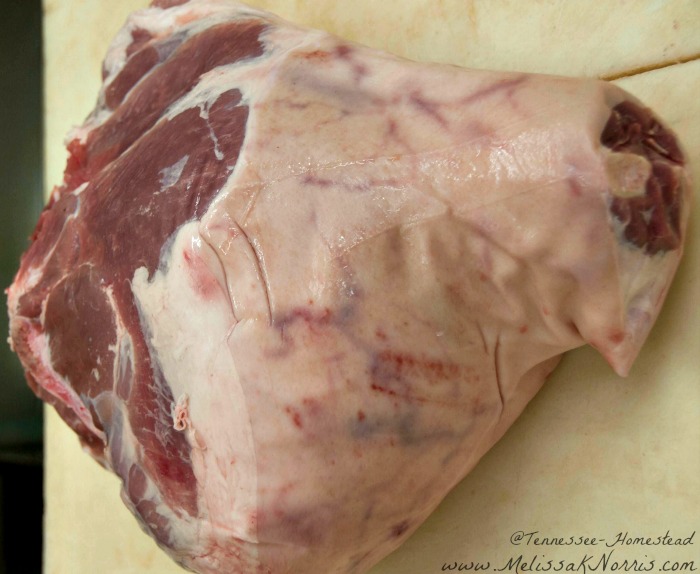
- Take a fresh ham with skin on, wash off in water and pat dry.
- Put a layer of curing mix on the tray to act as a bed for the ham. This bed of curing mix should be ¼" – ½" deep.
- Place the ham on top of the layer of mix.
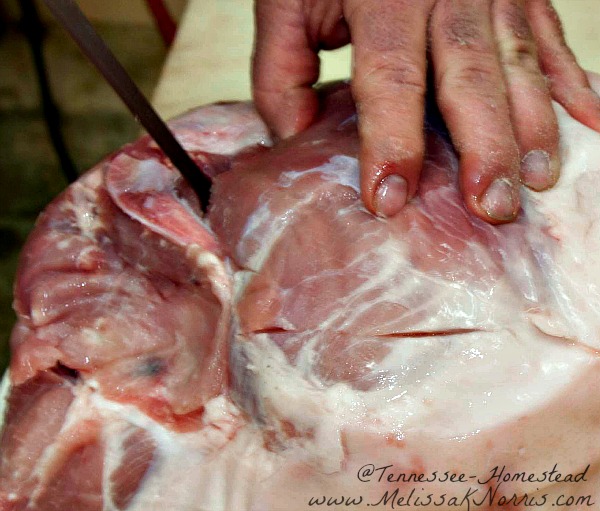
- At each joint, cut slits down to the bone. These slits are needed because you have to pack extra salt around the joint so the fluid will draw out. Otherwise, you could spoil the ham. There are two joints, the H-bone (hip) and the hock.
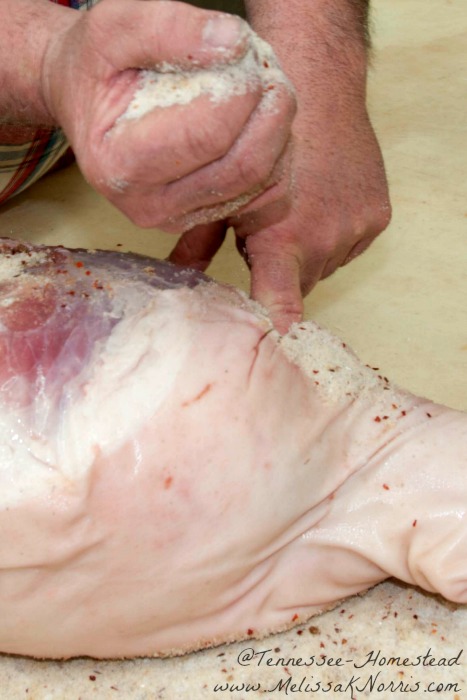
- Pack the slits you made at the joints with the curing mix.
- Rub and cover the rest of the ham with the curing mix.

- Leave the tray in a cool place (such as a refrigerator or a cooler packed with ice) for 18 days at 36-40 degrees. If using a cooler, be sure to check your ice daily and replenish it as needed.
- After 18 days check the ham.
- If you are going to put this ham in the smoker it has to be firm to the touch. If not firm to the touch it is not ready to come out of the curing mix. (If it is not firm it is because there is still too much fluid left in the ham.)
- If ham is ready to be smoked, thoroughly rinse off the salt and pat dry before smoking.
- If you are freezing then firmness does not matter. You can go on to the next step.
- If freezing, slice the ham and freeze or freeze whole.
- If ready to eat, you can bake the whole ham. Alternatively, you can slice the ham, soak the ham slices in cold water for up to an hour, then cook. Or, simmer the ham slice in a little water in the frying pan and then remove the water and continue cooking.
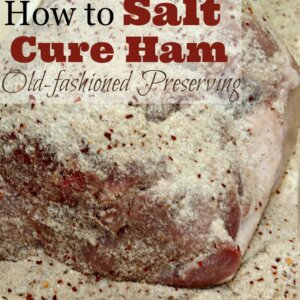
Salt Cured Ham: Old-Fashioned Preserving
Salt cured ham has been around for centuries as an old-fashioned preservation method. It's simple to cure your own ham at home with this easy recipe.
- 6 cups Curing Salt
- 3 Tbs Red pepper
- 3 Tbs Black pepper
- 3 cup Brown sugar
- 1 Fresh Ham
-
Mix salt, red pepper, black pepper and brown sugar in a bowl and set aside, this is your curing mix.
-
With a ham that's between 36 and 40 degrees Fahrenheit, rinse in cold water and pat dry.
-
Put a layer of curing mix ¼" – ½" deep on a tray to act as a bed for the ham.
-
Place the ham on top of the layer of curing mix.
-
At the H-bone (hip) and the hock joints, cut slits down to the bone then pack with as much of the salt mixture as possible.
-
Rub and cover the rest of the ham with the curing mix.
-
Leave the tray in a cool place (such as a refrigerator or a cooler packed with ice) for 18 days at 36-40 degrees.
-
Cure for 18 days (or more – see recipe notes).
-
Once the ham is cured, rinse well with cool water then smoke it, cook it or freeze it for later (see recipe notes for cooking tips).
- If using a cooler, be sure to check your ice daily and replenish it as needed.
- If you are going to smoke your ham, it has to be firm to the touch. If it's not firm to the touch, continue curing and checking it daily.
- If ham is ready to be smoked, thoroughly rinse off the salt and pat dry before smoking.
- If you are freezing then firmness does not matter. Slice the ham and freeze or freeze whole.
- When ready to eat, you can bake the whole ham.
- If you'd like to serve the ham in slices, we recommend soaking the slices in cold water for an hour up to 12 hours in the refrigerator. Then cook up in a frying pan. (You can also simmer the ham slice in a little water in the frying pan, remove the water, then continue cooking.
Serving: 1 oz. Calories: 69.7 kcal Protein: 5.2 g Fat: 5.3 g Saturated Fat: 1.9 g Cholesterol: 15.9 mg Sodium: 364 mg
Let us know how it was!
Here on the homestead, cured hams are just one of the products we make from our own hogs. Other products include lard, bacon, ham, ham hocks, sausage and souse meat. If you are unable to raise your own hog many local custom slaughterhouses can help you find a producer you can purchase a hog from so you too can have your own fresh pork and enjoy the process of curing your own meat.

Lee is a writer/blogger who is also a self-reliance promoter. They call her chicken "Mama" at home where she considers herself an expert pitchfork operator. For more self-reliance and homesteading tips from Lee go to Tennessee-Homestead.com
Source: https://melissaknorris.com/howtosaltcureham/
0 Response to "Recipes for Making Cured Beef Ham"
ارسال یک نظر